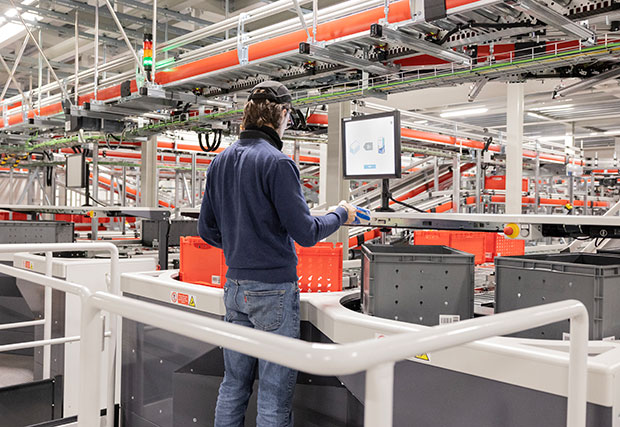In today’s competitive and rapidly changing global marketplace, fast, accurate and flexible material handling is no longer a luxury. It’s a must.

That’s why the spotlight is on robotic picking and fully autonomous warehouse systems. Innovations in artificial intelligence (AI), machine learning, and computer vision are transforming warehouses into dynamic, self-optimising ecosystems.
The outcome? Higher speed, lower costs, scalability on demand and unprecedented accuracy.
From fixed systems to flexible robots
Warehouse automation is not new. Back in the 1980s and 1990s, companies already deployed automated storage and retrieval systems (ASRS), conveyors, and palletising robots to streamline operations. These tools increased throughput and reduced manual labour.
Yet these first-generation solutions came with limits. Conveyors and stationary robotic arms were fixed in place, offering little flexibility when business needs changed. Even early automated guided vehicles (AGVs), while more mobile, were tied to predefined routes and lacked adaptability.
These systems were effective in their time, but the boom in e-commerce, with its fluctuating order volumes and diverse SKUs, exposed their shortcomings. Fulfilment centres needed faster, smarter, and more adaptable technology.
Breakthrough technology
The last decade has seen robotic picking evolve thanks to major technological leaps:
•Computer vision Equipped with advanced cameras and sensors, robots can now identify the dimensions and shape of products. This enables them to handle a wide range of items and allows AMRs and AGVs to navigate autonomously around obstacles with no fixed tracks required.
•Machine learning Robots continuously learn and improve. By analysing vast amounts of data, robotic arms can adjust automatically after a failed pick and refine their accuracy over time.
•Adaptive picking AI-driven gripping technology lets robots adjust their grip based on weight, material or fragility. That means fewer errors, less product damage and higher order accuracy.
Together, these advances make it possible to design holistic warehouses where every system collaborates to optimise the goods-to-person process, paving the way for fully autonomous fulfilment.
Inside the robotic warehouse
Every fulfilment centre is different, but fully autonomous facilities tend to share certain building blocks:
•Robotic depalletising machines unload incoming goods and scan them into inventory.
•ASRS with AI-driven shuttles store products based on demand and retrieve them when needed.
•Adaptive picking stations handle a wide variety of SKUs with robotic precision.
•Robotic packing systems wrap, seal and label items for shipping.
•Automated conveyors and sorters move orders seamlessly to outbound docks.
•Robotic palletisers finalise shipments and prepare them for transport.
At the heart of all this sits the Warehouse Management System (WMS), the digital control tower that integrates every component. It predicts demand surges, coordinates operations, and uses machine learning to optimise the entire workflow.
In many facilities today, this technology exists in a semi-autonomous form: robots handle the bulk of fulfilment while humans supervise and manage exceptions. Yet the trajectory is clear – the industry is steadily advancing toward fully autonomous operations.
Robotic picking at the core of fulfilment
Consumer expectations continue to rise. Same-day or next-day delivery has become the standard, while labour shortages and wage pressures make manual fulfilment harder to sustain.
That’s why companies are embracing robotic picking as the core engine of fulfilment. The advantages are clear:
•Operational consistency – Robots don’t need breaks or shift rotations.
•Lower labour costs – Fewer manual pickers are needed, especially during peak seasons.
•Scalability – Systems can flex up or down in response to demand spikes.
•Accuracy – Fewer errors mean fewer returns and happier customers.
For industries like fashion and consumer goods, where SKU diversity is enormous and seasonal spikes are the norm, robotic picking is becoming indispensable. By accelerating the goods-to-person process, companies can boost both efficiency and customer satisfaction.
The roadblocks to full autonomy
Moving to a fully autonomous warehouse is exciting but comes with challenges:
•High initial investment Robotics and automation systems require significant capital. Greenfield projects demand careful financial planning and ROI modelling. Leasing and financing options can help spread the costs.
•Complex edge cases Robots can struggle with irregularly shaped items, damaged goods, or incorrect labelling. While AI and machine learning reduce these issues, companies should still run simulations before deployment to anticipate exceptions.
•Integration complexity Every component must communicate seamlessly, which means deep integration with WMS and ERP software. A fragmented setup can lead to costly inefficiencies.
These hurdles are real, but they’re not insurmountable. With the right technology partners, businesses can implement robotic systems smoothly and progressively.
Getting future-ready
Transitioning to robotics doesn’t have to happen overnight. A major advantage of today’s warehouse solutions is their modularity and scalability, which allow companies to move forward step by step. For instance, businesses can start small with flexible robotic picking arms such as RovoFlex, which seamlessly switch between manual and automated modes. They can then expand by deploying AMRs and AGVs that can easily be added or removed to match seasonal peaks or quieter periods. Another option is adopting scalable systems like FlashPick, which evolve alongside the business and adapt to shifting order profiles.
Before committing to larger investments, companies can also make use of emulation and simulation tools to model warehouse layouts and test system performance in a virtual environment. This approach minimises risk and ensures that every new solution aligns with operational goals.
The future is now
The logistics industry is on the cusp of a new era. With AI, machine learning, and computer vision at the core, warehouses are evolving into autonomous ecosystems that balance speed, efficiency, and customer satisfaction.
For companies willing to invest, the benefits are significant: faster throughput, reduced costs, higher accuracy, and a supply chain that can keep pace with modern consumer demands.
Fully autonomous material handling is no longer science fiction. It’s within reach and the companies that embrace it today will define the competitive landscape of tomorrow.
More information can be found at: www.tgw-group.com




Comments are closed.